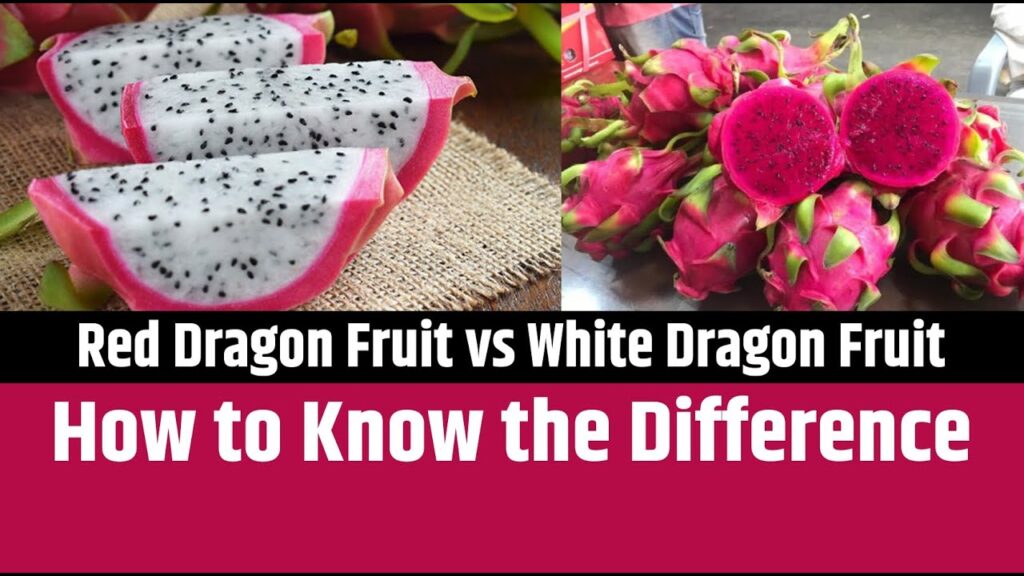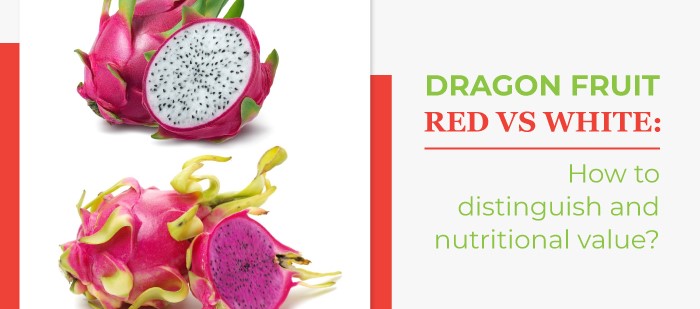Let’s embark on a detailed exploration, dissecting the subtle intricacies red Vs white dragon fruit. While they share a common lineage within the cactus family, each variety unfurls a unique tapestry of characteristics, from visual aesthetics to flavour nuances.In the realm of exotic fruits, the red and white dragon fruit stands as a captivating ambassadors of tropical allure.
Red Vs White dragon fruit:

Visual differences
The initial encounter with these fruits often begins with a feast for the eyes, courtesy of their visual differences.
- Red Dragon Fruit: Nature’s brush strokes paint the skin of the red dragon fruit in vibrant hues of pink or red. Adorned with scales or spikes, the outer layer conceals a flesh that can be either red or white, studded with petite, ebony seeds.
- White Dragon Fruit: In contrast, the white dragon fruit boasts a more subdued palette, with skin hues ranging from yellow to pink. Lacking intense red pigmentation, its exterior hints at the softer, pastel tones within. The white dragon fruit’s flesh is primarily white, as the name suggests, with the same distinctive black seeds throughout.
Taste differences
Beyond the visual allure, the true essence of these fruits lies in their taste difference, offering a gustatory journey that sets them apart.
- Red Dragon Fruit: Indulging in the red-fleshed variety reveals a flavour symphony characterized by a delicate sweetness, often deemed more pronounced compared to its white counterpart. The taste is a harmonious blend of sweetness with subtle floral undertones, creating a sensory experience that lingers.
- White Dragon Fruit: On the palate, the white dragon fruit unfolds a milder and slightly sweeter taste. Some describe it as reminiscent of melons, with a nuanced sweetness that is gentle and inviting. The flavor, though distinct, carries a subtlety that allows for versatile culinary applications.

Nutritional value difference
In the realm of nutrition, both red and white dragon fruits share common ground, offering a wealth of essential nutrients in every succulent bite.
- Both varieties are low in calories, making them a guilt-free indulgence for those mindful of their calorie intake.
- Rich in vitamin C, these fruits contribute to immune health and collagen synthesis, promoting radiant skin.
- The presence of B vitamins (B1, B2, and B3) adds a layer of nutritional complexity, supporting energy metabolism and overall vitality.
- Essential minerals like iron and phosphorus are also present, fortifying the body’s mineral reserves.
- A noteworthy component is fiber, aiding digestion and contributing to a sense of satiety.
Pigment Palette: Colours of Health
The vibrant hues of dragon fruit extend beyond aesthetics, revealing insights into their nutritional composition.
- Red Dragon Fruit: The intense red or pink colour of the flesh is attributed to natural pigments called betalains, specifically betacyanins. These compounds not only lend the fruit its captivating colour but also contribute to its antioxidant prowess.
- White Dragon Fruit: In contrast, the white dragon fruit’s flesh lacks the betacyanins that define its red counterpart. The absence of these pigments results in a paler hue, signifying a different antioxidant composition.
Culinary Versatility
Both red and white dragon fruits offer a canvas for culinary creativity, seamlessly integrating into a myriad of dishes.
- Whether diced into fruit salads, blended into refreshing smoothies, or featured as an exotic topping for desserts, these fruits lend a tropical flair to culinary creations.
- The mild sweetness and visually appealing speckled appearance make them a favourite for garnishing and plating, adding a touch of elegance to any dish.

Geographical Variability
The prevalence of red or white dragon fruit may vary based on geographical factors and local cultivation practices.
- In some regions, the red dragon fruit might dominate orchards, with its vibrant hues accentuating tropical landscapes.
- Conversely, in other locales, the white dragon fruit might be the more prominent variety, showcasing its subtler tones amidst the lush greenery.
Consumer Preferences
Ultimately, the preference for red or white dragon fruit often boils down to individual taste preferences.
- Some may be drawn to the robust sweetness and striking visual appeal of the red dragon fruit.
- Others might favor the subtler, milder sweetness of the white dragon fruit, appreciating its versatility in culinary applications.
Final Verdict: A Fruitful Choice
In the grand tapestry of gastronomy, the red dragon fruit and white dragon fruit each bring a unique flavor profile, visual charm, and nutritional richness to the table. Whether enjoyed independently or as part of culinary creations, these fruits invite exploration and offer a delightful journey through tropical indulgence.
As you navigate the world of exotic fruits, consider the nuances that set the red and white dragon fruits apart. Embrace the diversity they bring to your palate, and relish the opportunity to savour nature’s bounty in every captivating bite.
While red dragon fruit (Hylocereus costaricensis) is generally considered nutritious and beneficial, there isn’t a significant disadvantage for most people. However, preferences for taste and sweetness can be subjective, and some individuals might find the flavor of red dragon fruit less sweet compared to other varieties, such as white dragon fruit.
FAQ’s
Which is better red or white dragon fruit?
The preference for red or white dragon fruit is subjective and depends on individual taste preferences. Both red and white dragon fruit varieties are nutritious and offer unique flavors. Here are some general characteristics of each:
Red Dragon Fruit (Hylocereus costaricensis):
Taste: Mildly sweet with a subtle flavor reminiscent of kiwi and pear.
Color: The flesh is typically red or pink.
Nutritional Content: Rich in antioxidants, vitamins, and minerals.
White Dragon Fruit (Hylocereus undatus):
Taste: Generally sweeter than the red variety, with a flavor reminiscent of kiwi and pear.
Color: The flesh is typically white or sometimes has tiny black seeds.
Nutritional Content: Also rich in antioxidants, vitamins, and minerals.
Which dragon fruit taste better pink or white?
The taste preference between pink and white dragon fruit is subjective and can vary from person to person. However, it’s important to note that the color of the dragon fruit’s flesh can change based on the specific variety and ripeness rather than indicating a distinct flavor difference.
Which dragon fruit is best?
Determining the “best” dragon fruit is subjective, as it largely depends on individual taste preferences. Both red and white dragon fruit varieties are popular and nutritious, offering unique flavors and textures
What is the disadvantage of red dragon fruit?
Less Sweetness: Compared to white dragon fruit, some individuals find that red dragon fruit is less sweet. This can be a disadvantage for those who prefer a sweeter taste.
Color Staining: The vibrant red or pink color of the flesh can stain clothing or surfaces, so it’s advisable to be cautious when handling and consuming red dragon fruit.
Mild Taste: Some people may find the taste of red dragon fruit to be milder compared to other fruits, and personal taste preferences may vary.
